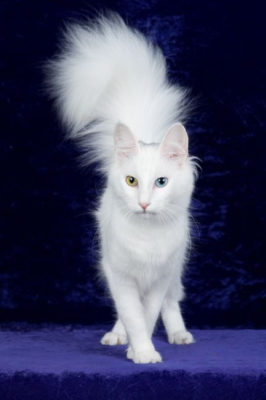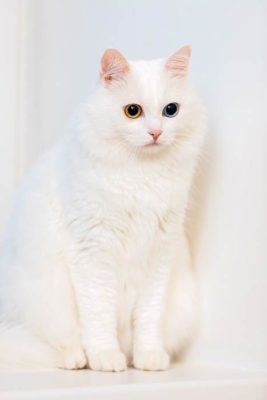Turkish Angora
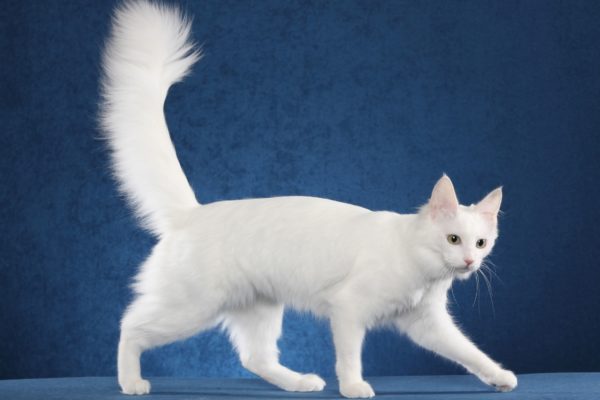
Angoras are very talkative cats, striving to please their owners all the time. It is hard to say what character traits of an Angora cat attract people more. Many Angora cat breeders claim that they are ideal for families with small children. They are very active; they like to play, they are knowledgeable and inquisitive.
Table of Contents
Breed Information
| Origin | Turkey |
| Size | Males 30-34 cm Females 27-30 cm |
| Weight | Males 4-6 kg Females 3-5 kg |
| Fur Type | Semi-long-haired |
| Color | All colors and coat patterns |
| Lifestyle | Outdoors, indoors |
| Lifespan | 15-18 years |
| FIFe Classification | Category II: “Semi-long-haired” Breed designation – TUA |
| WCF Classification | Group 2: “Semi-long-haired” Breed designation – TUA |
| TICA Classification | TA |
| Group | Long-haired cats, cats for kids |
| Price | $600-800 |
Breed Photos
Origin History
The Turkish Angora is considered one of the oldest breeds in the world. These graceful cats with soft fur appeared many centuries ago in Turkey’s Angora Mountains, in the city now known as Ankara. According to legends, the Prophet Muhammad had such a cat, who loved the company of his furry companion Muizza. Maybe that’s why cats are the only animals allowed to cross the threshold of a mosque.
The Turkish Angora cat breed was wildly popular among French aristocrats for its gracefulness and luxurious white coat. King Louis XVI allowed his Angora cats to walk around the table during state meetings. His wife Marie-Antoinette sent her pets by ship to America, saving their lives.
The Angora cat was registered as a separate breed only in 1973. The International Cat Association recognized Angora in 1979.
Appearance
The best known white color among the Turkish Angora breed, but cats of other colors have been bred for many years. Their long hair is a result of the cold climate. Scientists believe that the Turkish Angora is the only breed whose longhair gene appeared due to a natural mutation.
Long silky hair and almond-shaped eyes distinguish Turkish Angora cats from other cat breeds. Their eyes come in various colors – green, blue, golden, and there are also cats with heterochromia. Colored eyes are fraught with deafness in one ear. Interestingly, a cat is deaf on the side where the blue eye is, and normal hearing is on the side where the eye is of another color.
Angora cats are characterized by large pointed ears, elongated body, medium size, slender legs. The tail resembles an ostrich feather, very long and fluffy. This breed’s representatives can even be compared with ballerinas – slimness, grace, and elegance ooze from Turkish Angora cats.
Character
Angoras are very talkative cats, striving to please their owners all the time. It is hard to say what character traits of an Angora cat attract people more. Many Angora cat breeders claim that they are ideal for families with small children. They are very active; they like to play, they are knowledgeable and inquisitive. Angoras are soft and affectionate cats; they like to spend time on their owners’ hands, knees, or other parts of the body.
Care
Despite their long hair, angoras do not need any special care. They shed very little since they have no undercoat, and once or twice a week, they need to be brushed with a furminator. You should bathe at least once a month and periodically examine the eyes and ears of your cat to remove dirt. Cats are extremely curious and stick their paws everywhere; they will have to be washed often to prevent pets from spreading dirt around the house.
Education
Turkish Angora cats are often compared to dogs. They gladly respond to commands, fetch a ball and play the snake game. Turkish Angora will gladly learn new commands only if the training is easy and in the form of a game. If the cat feels a little pressure or questions its freedom and dignity, you will immediately know who is the master of the house. Turkish Angora knows how to put a negligent man in his place!
Common Diseases
The Turkish Angora is a healthy breed, generally able to live up to 20 years. Since many cats suffer from a lack of exercise, veterinarians advise watching their weight and avoid obesity. Overweight cats are more prone to diabetes and kidney disease, cardiovascular disease, and musculoskeletal diseases.
Angora cats are prone to ataxia, a hereditary disease that manifests itself in movement coordination disorder. Angora deafness does not bypass; it most often affects animals of white color with blue eyes. Among other widespread diseases among angora cats, there are also caliciviruses, herpes, urolithiasis, epiphora, aspergillosis, and panleukopenia.
Nutrition
As natural products, Turkish Angoras can eat chicken or turkey, beef, veal, rabbit, lamb, but in no case pork. Meat is better served boiled, but sometimes you can treat the little carnivore and raw, pre-cooked meat. Angoras should be given dairy products, fresh herbs, and vegetables – carrots, beet, but in any case, not potatoes; it is poorly digested in the stomach. But it is best to transfer the pet to super-premium or premium food. This food has all the nutrients necessary for the Turkish Angora in a balanced form.
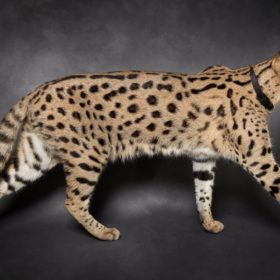 Savannah
Savannah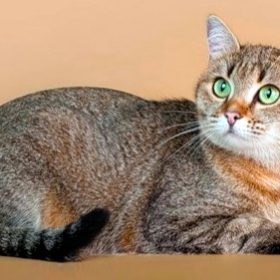 Celtic Shorthair (European Shorthair)
Celtic Shorthair (European Shorthair)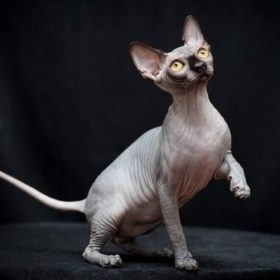 Sphynx (Canadian)
Sphynx (Canadian)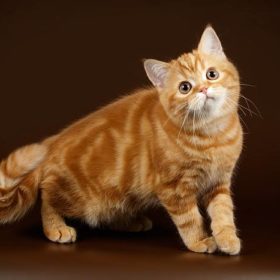 Scottish Straight
Scottish Straight Thai
Thai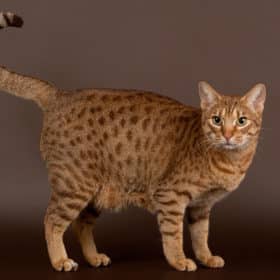 Ocicat
Ocicat